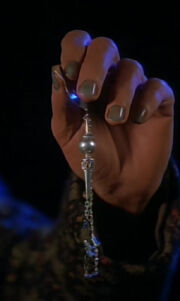(→Culture and Society: names) |
|||
| Line 67: | Line 67: | ||
===Music=== |
===Music=== |
||
Bajor, as an advanced society, was well-known for its [[music]] both before, and after, the Occupation. The [[Jalanda Forum]] was a popular performance venue. The [[Bellaclavion]] was a Bajoran musical instrument. |
Bajor, as an advanced society, was well-known for its [[music]] both before, and after, the Occupation. The [[Jalanda Forum]] was a popular performance venue. The [[Bellaclavion]] was a Bajoran musical instrument. |
||
| + | |||
| + | ===Names=== |
||
| + | Bajoran custom places the surname (or family name) before the given name (the opposite of the practice in English). Therefore, [[Major]] [[Kira Nerys]] would properly be addressed as Major Kira, not Major Nerys. |
||
==Technology== |
==Technology== |
||
Revision as of 22:54, 11 May 2005
| File:Bajor-Logo.jpg | |
| Caption: | The official emblem of the Bajoran people |
| File:Leeta2374.jpg | |
| Caption: | Leeta, a Bajoran female in 2374 |
| File:Bariel.jpg | |
| Caption: | Vedek Bareil Antos, a Bajoran male in 2369 |
The Bajorans (also known by their native name, "Bajora") are a humanoid species native to the planet Bajor in the Alpha Quadrant. The Bajorans have one of the oldest and richest cultures in the quadrant, though in recent history they have suffered greatly at the hands of the Cardassian Union. With their liberation from the Cardassians and the discovery of the Bajoran wormhole, the Bajorans are taking a new place as major players on the interstellar stage.
Physiology
Bajorans resemble Humans in appearance, and are distinguished by a series of four to seven creases across their noses. The Bajoran heart is mirrored along a horizontal axis, unlike the human heart, which is mirrored along a vertical axis. A puncture in the lower ventricle of the heart will cause instantaneous death. Bajoran women gestate for only five months, forming an intricate network of blood vessels between the mother and the fetus. During the pregnancy, Bajoran women are frequently afflicted by bouts of uncontrollable sneezing. (TNG: "Descent, Part I", DS9: "Body Parts", "Looking for par'Mach in All the Wrong Places")
History
Ancient Bajor
Bajoran civilization stretches back more than half a million years, which is long Before humans learned to speak or make bonetools. The ancient Bajorans were renowned for their accomplishments in science, mathematics, philosophy, and the arts. The greatest of these early Bajoran civilizations was the First Republic, which flourished between 25,000 and 20,000 years ago. During this time, magnificent cities such as B'hala were built.
The next great phase of Bajoran civilization began approximately 10,000 years ago, when the first of the Tears of the Prophets were discovered above Bajor. These artifacts ushered in a new era of spiritual connection with the Bajoran gods, the Prophets. By the 16th Century, the Bajorans had developed sublight space travel and were exploring their home star system with solar-sail spacecraft. Some Bajoran explorers even reached the Cardassia system, several light-years away. In the 24th Century, this period came to an end with the annexation of Bajor by Cardassia. (TNG: "Ensign Ro", DS9: "Rapture", "Emissary", "Explorers")
Cardassian Occupation
Main article: Occupation of Bajor
The Occupation of Bajor (usually simply referred to as the Occupation) was the period from 2328 to 2369 during which the Bajoran homeworld of Bajor was under the control of the Cardassian Union. During the Occupation, the Cardassians perpetrated a coordinated scheme of strip-mining, forced labor, and genocide across the planet. The Occupation gave rise to the fierce Bajoran Resistance, which used guerilla and terror tactics to eventually force the Cardassians to withdraw. Many Bajorans also fled the occupation and settled on planets all over the known galaxy, but almost everywhere they remained separated from other peoples, living under the poorest circumstances in refugee camps like those on Valo II.
Independent Bajor
In 2369, after nearly forty years of domination over Bajor, the Cardassians finally left, no longer willing to stand against the relentless terrorism of the Bajoran Resistance. As the Bajorans established an independent government, the United Federation of Planets moved into the system and, along with the Bajoran military, established joint control of Terok Nor, a mining station, which they renamed Deep Space Nine. Bajor applied for membership in the Federation in 2373, but retracted their application at the last moment because their Emissary told them this would be desastrous for Bajor. The two governments maintained a cordial relationship, however.
Prior to the beginning of the Dominion War, Bajor signed a nonaggression pact with the Dominion, choosing to remain neutral. This saved Bajor from coming under the rule of another foreign power when the Dominion captured Deep Space Nine in late 2373. Bajor finally joined the fight against the Dominion in 2374 after the Allies recaptured Deep Space Nine in the Battle of Bajor. The Bajorans continued to fight against the Dominion until 2375, when the Treaty of Bajor was signed on Deep Space Nine in 2375. Following the war, Bajor resumed its attempt to become a member of the United Federation of Planets. (DS9: "Emissary", "Rapture", "Call to Arms", "Favor the Bold", "Sacrifice of Angels", "What You Leave Behind")
Government
Following the Cardassian withdrawal from Bajor, the interim Bajoran Provisional Government was set up to administer the planet and its various colonies. Bajoran politics is balanced between the secular Chamber of Ministers, led by the First Minister, and the religious Vedek Assembly, led by the kai. It is possible for one individual to be both the kai and the first minister simultaneously, as Winn Adami almost was in 2371. (DS9: "Shakaar")
Religion and Spirituality
Kai Winn Adami.
The Bajoran religion is a major unifying force on the planet; the spiritual leader, or Kai, wields a great deal of moral and political authority, advising and influencing the planet's political leader, the First Minister. The Kai is chosen from a council of Vedeks, the title given to Bajoran religious leaders. Other religious titles are Ranjens and Prylars. The Bajoran religion is based upon the revelations of the Prophets, who come to be known as the timeless beings residing in the Bajoran wormhole, or as it is called by the Bajorans, the Celestial Temple. Since Starfleet officer Benjamin Sisko was the first to make contact with them, he is acclaimed by the Bajoran spiritual leadership as the Emissary of the Prophets. Part of the Bajoran religion involves the use of the Tears of the Prophets, reality-distorting energy orbs produced by the Prophets. Several of these were stolen by the Cardassians during the Occupation, though a number have been recovered.
Language
See main article Bajoran language Spoken Bajoran has many dialects and is used as the official language of Bajor and its colonies. It's generally more simple than spoken English, however many Bajorans are becoming bilingual, most learning English for Bajor's imminent admittance to the Federation.
Bajoran script
The Bajoran written language consists of square symbols which are composed of thick lines. There are a large number of different symbols which can be used in any of four rotations (normal, horizontally flipped, vertically flipped, 180 degree rotation). This gives anywhere between 50 to 200 symbols in the written language. The number of characters in the script implies that its either syllabic or logosyllabic. Modern Bajoran text usually requires pairs of symbols to write words and concepts, although odd numbers of characters are also used in bajoran texts (possibly as abbreviations). Both ancient and modern Bajoran text has been called ideographic - each character or a pair of characters represents a single thought pictured, however as with Chinese (most chinese characters represent syllables and have a semantic component, they are very few true ideograms), this is probably a misconception. Given the possible number of symbols, Bajoran writing is likely syllabic or logosyllabic.
Culture and Society
Bajoran culture and customs are closely tied with Bajor's religious beliefs.

A Bajoran earring.
Earrings
Most Bajorans wear elaborate earrings on their right side as a symbol of their faith. These earrings can be made from various metals, such as diamide-laced beritium. Each person's earring is individualized and bears the symbol of their family. Prior to the Occupation, these earrings also indicated one's D'jarra, or social caste. Bajoran earrings are one of the few exceptions to Starfleet's uniform code. (TNG: "Ensign Ro"), but nevertheless, Tuvok ordered the Bajoran Gerron to take his earing off. At least Tuvok did not say he could continue wearing it. He even acknowleged that he may not wear it. (VOY: "Learning Curve")
Childbirth

Kira Nerys giving birth.
The traditional Bajoran birthing ceremony is attended by the woman's family and a midwife. The objective of the ritual is to induce complete relaxation through a combination of breathing exercises, rhythmic percussion music and incense, allowing the woman to give birth without pain. However, the birth must take place in a certain period of time, or the level of endorphins within the mother's system will build to toxic levels.
When the child is born into the world, he or she is greeted with the following words: "Awake child, we await you with love and welcome you into the world." (DS9: "Shakaar")
Funerary customs
The Bajorans generally bury their deceased in graves marked with a decorated arch. Bajoran funeral rites can be quite elaborate; for example, the Bajoran death chant is over two hours long. However, the preservation of the body itself is not of particular significance to the Bajorans, who believe that after death a person's pagh joins the Prophets in the Celestial Temple, leaving only an empty shell. To mourn the death of a loved one, Bajorans light duranja lamps.(DS9: "Shakaar", "Indiscretion", "Ties of Blood and Water")
Music
Bajor, as an advanced society, was well-known for its music both before, and after, the Occupation. The Jalanda Forum was a popular performance venue. The Bellaclavion was a Bajoran musical instrument.
Names
Bajoran custom places the surname (or family name) before the given name (the opposite of the practice in English). Therefore, Major Kira Nerys would properly be addressed as Major Kira, not Major Nerys.
Technology
- Antares class (freighter)
- Bajoran fighter
- Bajoran interceptor
- Bajoran lightship
- Bajoran transport
Holidays and Festivals
Food and Beverages
- Alvas
- Bajoran shrimp
- Deka tea
- Foraiga
- Groatcake
- Hasperat
- Hasperat souffle
- Jumja stick
- Jumja tea
- Kava
- Kava juice
- Katterpod
- Klavaatu
- Koganka pudding
- Larish pie
- Mapa bread
- Moba fruit
- Rekja
- Springwine
- Synthale or Bajoran ale
- Tuwaly pie
- Veklava
People
- List of Bajorans
